It is important to utilize state-of-the-art technology for quick and dependable data communication in this modern world. Among various optical fiber technologies, OM3 fiber optic technology marks a huge stride in optical fibers’ performance, making it ideal for high bandwidth needs. This article presents many benefits of using OM3 fiber optics over other types by explaining what they are better at and their capacities and uses within industries. Looking into this detailed comparison based on technical aspects alone while also considering operational efficiencies related to these two things combined together, such as reliability and efficiency, will allow anyone who reads through it to understand why most people consider them necessary for establishing sturdy data networks.
What is OM3 Fiber Optic Cable?

Understanding OM3 Standards
The 50/125-micrometer core diameter standard is followed by the OM3 fiber optic cables, which are ideal for laser transmission. These cables have been made with the intention of supporting higher data rates for longer distances than their predecessors, like OM1 and OM2, did. What makes up the OM3 standard is its capability to work with 10 Gigabit Ethernet (10GbE) over a distance of 300 meters and also support 40/100 Gigabit Ethernet (40/100GbE) at a range of up to 100 meters, which makes it perfect for use in large-scale data centers and enterprise networks. Apart from that, another thing about these types of multimode fibers is that they are usually colored aqua and, hence, can be easily differentiated from others.
Performance Features of OM3 Fiber Cables
Fiber optic cables are key for data communication in today’s world. There are many reasons why this is so, but the most important one is its ability to provide bandwidth. Specifically, these cables have 2000 MHz*km, which is much higher than other types of multimode fibers that were used before them. This extra capacity means quicker transmission and less waiting time. Also, they exhibit better modal bandwidth, an attribute necessary for reducing dispersion among modes as well as preserving signal quality over long distances traveled by light waves through such media as OM3 fiber optic cable. Moreover, they support quick transmission protocols and hence can scale easily up to 10GbE, 40GbE, or even 100 GBE networks depending on need, thus making it future-proof. Another thing is their low insertion loss and strong light-carrying capabilities all contribute greatly towards efficiency and reliability improvement, making them ideal for use within data centers plus high-performance computing environments, among others, where a fast connection is required most frequently.
Applications of OM3 Fiber in Data Centers
OM3 fiber optic cables are widely used in data centers because of their good performance and reliability. One area where they are applied most is high-speed interconnects whereby efficient links between servers, storage systems, and network equipment that support up to 100GbE data transferring speeds are made using OM3 fibers. These fibers are also used at the core infrastructure to handle massive amounts of data traffic so that they can move smoothly over different parts of the DCI without delay or interruption. Moreover, OM3 supports cloud computing environments as well as virtualization since such setups require high bandwidths with low latencies for optimal performances to be realized. It can work with many protocols like Ethernet and Fiber Channel, among others, hence making them versatile enough to be applicable in various high-speed networking scenarios within data centers.
How Does OM3 Differ From Other Fiber Optic Cables?

OM3 vs OM4: Key Differences
When you compare the fiber optic cables OM3 and OM4, there are a number of key differences that come to light — those being in bandwidth and distance capabilities. Bandwidth is constructed to be higher in OM4 fiber as opposed to OM3, with an average mode bandwidth of 4700 MHz·km for the former and 2500 MHz·km for the latter. This means that more data can be sent through it over longer distances; specifically speaking this means 40GbE over 150 meters or even up to 100GbE if needed while still staying within limits set by the IEEE standards committee.
Another difference between these two types would have something about costs which may vary slightly due primarily on performance characteristics wherefore one is cheaper or expensive than other ones but this does not matter much since most data centers prefer using them because they’re able to support wider network coverage in future.
Still, on physical attributes, both multimode fibers use the same connectors plus transceivers, notwithstanding slight disparities in sizes, which means they are compatible with each other —OM3 & OM4– fiber optics cables. What sets them apart, however, is their ability to deliver high speeds, therefore making the latter more ideal for robust networks, especially those involving frequent large-transmission environments; although costly, it is worth investment even though it might seem so when compared to the former type(OM3).
Comparing OM3 with OM1 and OM2
Bandwidth, distance capabilities, and core size are among the features of OM3 fiber optic cables that differentiate them from OM1 and OM2. Regarding bandwidth, OM1 utilizes a 62.5-micron core aimed at applications with low capacity. In this regard, it can support up to 1GbE over 300 meters or 10GbE up to 33 meters. Similarly, OM2 also has a core of 50 microns but offers slightly better performance than OM1 while limited only up to 600 meters for 1GbE and as far as 82 meters concerning 10GbE.
On the other hand, unlike its predecessors, which were optimized for LED-based systems, OM3 fiber is laser-optimized with a core diameter of 50 microns, which allows higher bandwidth over longer distances (Lekkas). For example, it can achieve this by supporting a minimum speed of transmitting at the rate equal to or greater than ten billion bits per second within three hundred meters between any two points connected through such media (Gilder). Additionally, forty gigabits per second may be transmitted using one hundred meter-long segments while one hundred Gbps could be sustained within corresponding limits along these same lines where applicable. This increase is mainly due to increased effective modal bandwidth (EMB) which is approximately twenty-five hundred megahertz-kilometer.
In general terms then, therefore, it would seem that if you have got anything more demanding in mind than what an average person might want when setting up their own home network system – say something like running multiple virtual private networks simultaneously over gigabit Ethernet connections spanning hundreds or thousands of miles apart from each other – then really nothing less will do except for opting into using those superior qualities found abundantly within all aspects pertaining towards modern high-speed networking environments such as those required by OM3 fibers beyond any possible comparison against either equivalent quantities coming out from OM1 and OM2.
Choosing Between Single-Mode and Multi-Mode Fiber
Deciding on single-mode or multi-mode fiber requires considering several critical factors and referring to the best sources of information available on the matter.
- Distance and bandwidth needs: Single-mode fiber can send data over many kilometers with low signal loss and higher bandwidth capabilities, which is why it is preferred for long-distance communication. Conversely, multi-mode fiber works better for shorter distances – typically up to 550 meters for 10GbE – hence its use in data centers and local area networks (LANs).
- Cost Factors: When it comes to cost efficiency, both for the cable itself and transceivers associated with it, multi-mode fiber tends to be more favorable. Nevertheless, suppose an application needs high performance over a great distance. In that case, single-mode fibers may be expensive at first, but they are worth every penny due to their wider coverage areas coupled with increased bandwidths.
- Application Specificity: Usually, choices are made according to what is most suitable based on where something will be deployed; this also applies here. For instance, because of its limited ability in terms of distance within which signals can travel without significant attenuation taking place, multimode fibers are usually best suited for indoor use, such as for networking buildings that are close together, while single-mode fiber cables are used widely in telecommunications as well as long-haul networks since they allow transmission over much larger distances without any notable weakening of signals occurring along them.
In conclusion, whether one should go with single mode or multimode optical fiber depends on how far apart things need to communicate (distance), how much information needs to be carried at once (bandwidth), what it costs initial outlay versus lifetime running costs, etcetera tailored specifically around your network infrastructure needs.
What are the Advantages of OM3 Multimode Fiber?

High-Performance Bandwith Capabilities
OM3 multimode fiber has a greater capacity for bandwidth because of its design and is optimized for lasers. This design helps it to support data rates that are as high as 10 Gbps over distances of up to 300 meters, thereby making the fiber ideal for use in high-speed network backbones and data centers. More specifically, OM3 fibers have been created with a view towards ensuring that they work effectively together with VCSEL (Vertical-Cavity Surface-Emitting Laser) technology which allows higher rates of transmission without modal dispersion than can be achieved through traditional multimode fibers. Also worth noting is the fact that such kind of fibers are able to communicate with old systems; hence they provide an affordable way of increasing capacity without necessarily replacing all components within a network infrastructure where upgrades are required. The above combination explains why this type of fiber is necessary in current fast-paced communication environments.
Enhanced Laser Compatibility
Fiber optic cables like the OM3 multimode fiber are made to work well with VCSEL or Vertical Cavity Surface Emitting Laser technology as one of its essential features. This particular laser optimization increases data transmission efficiency by reducing modal dispersion, which is a problem experienced by traditional multimode fibers. Unlike other lasers, VCSELs emit light more directly into the core area of an OM3 fiber; hence, it facilitates faster and more reliable data transfer over long distances supported by such cables. Furthermore, these types of fibers have better compatibility with lasers, thereby enabling them to support high data rates that can be utilized even in robust network environments like enterprise backbones or data centers where performance is critical. This means that it offers cost-effective solutions for applications demanding both affordability and high-performance capabilities.
Cost-Effectiveness in Data Center Applications
OM3 fiber optic cables are a good investment for data centers because they provide high-speed data transmission without requiring new infrastructure. According to experts, replacing current cabling with OM3 cables can lead to dramatic savings in network costs by creating an easy migration path to higher bandwidths that is also compatible with older systems. In addition, using VCSEL technology within these same fibers consumes less power and cooling energy, which lowers operational expenses even further, still saving money! That’s why many businesses see this as being cost-effective; they can improve their networks’ performance levels without spending large amounts on capital investments.
How to Properly Install OM3 Fiber Optic Cable?

Preparing Your LC Connector
To ensure that an OM3 fiber optic cable has an LC connector installed in the right manner, there are steps that you must follow to guarantee connectivity and performance. Firstly, cautiously strip off the outer jacket of the fiber optic cable so as to expose buffered fiber. Make use of a fiber-optic stripper to get rid of about 1.5 inches of buffer coating, thereby revealing naked fibers beneath; these should then be cleaned using isopropyl alcohol together with lint-free wipes so as to remove any residue or contamination.
Secondly, cleave the fiber for creating flat and even end face. A perfect 90-degree angle must be achieved on this part by employing accurate cleavers during such process . Insert it into LC connectors through threading from backside up until there is direct contact between both tips at which point they should align perfectly together without any gap visible before proceeding further with other connection steps like crimping tool etc.
Ultimately, polish connector ends faces by means of fine-grained polishing film, starting with a coarse one that removes rough edges and then progressively finer ones till mirror-like finishes are attained, which guarantees minimum signal losses, hence the best possible data transfers via connections. Quality control ought not only to stop here but also extend checking them under microscopes, making inspecting polished connectors easier than before, therefore making sure everything is done according to the standards set out within this field besides being a necessary step towards completion. When all these rules have been adhered to, then we can say our work on the installation process of LC connectors over OM3 cables has come to an end.
Best Practices for Multimode Fiber Installation
- Appropriate Operation and Cleaning: To prevent destruction, at all times treat optical fiber cords with care. Before you make any connections, use isopropyl alcohol and lint-free wipes to clean all connectors for better signal transmission.
- Bend Radius Management: Follow the minimum bend radius specifications of the manufacturer for multimode fiber optic cable to avoid loss of signal quality as well as potential damage on the cable. Do not use tight corners or pull too hard.
- Testing and Verification: Use optical time domain reflectometers (OTDR) or power meters for comprehensive testing that ensures installations meet required performance standards. Regularly check and test fibers so that any possible problem can be detected early enough while there is still room for correction.
- Environmental Considerations: Pay attention to where you are installing them. Such places should not have high temperatures, chemicals or moisture that can weaken the fibers’ integrity. If installation areas are prone to physical hazards, appropriate protective coverings should be used.
- Labeling and Documentation: Label every fiber cable and connector clearly so that during maintenance, one does not get confused. Keep good records showing how they are connected together with their points of reference.
If these guidelines are followed, a strong reliable multi mode fibre optic network will be achieved which provides high performance connectivity consistently.
Ensuring Optimal Performance and Safety
For a safe and efficient installation of multimode fibers, it is necessary to consider the following main points:
- Cable Preparation and Installation: It is important that you prepare your cables correctly before installing them. This involves stripping, cleaning and cleaving for precise end faces. During installation, follow industry standards and best practices so as not to damage the cable.
- Connector Quality and Integrity: Use connectors of high quality and ensure they are properly mated to avoid signal loss. Regularly inspect connectors for cleanliness as well as integrity; replace any showing signs of wear or damage.
- Proper Network Design: Your network should be designed with few splices or connectors which could cause signal loss. The design should also allow for future growth and scalability.
- Regular Maintenance and Monitoring: Establish an inspection routine where all connectors are inspected and cleaned regularly alongside cables. Employ monitoring tools like OTDRs (Optical Time Domain Reflectometers) and power meters in order to keep track of network degradation continuously.
By concentrating on these areas considered critical, it will be possible to have a safe multimodal fiber optic network operating at its highest efficiency both now and in the future when new connections arise.
Understanding OM3 Patch Cable Solutions

The Role of Duplex Cables
Duplex cables are very important for fast data transmission nowadays, especially in enterprise data centers and telecommunications networks. Such cables contain two fibers in a single jacket, which can then be used for transmission in both directions at the same time. This arrangement is necessary for applications that need to send and receive signals on different fiber strands. Duplex cables are widely used in 10 Gigabit Ethernet, Fibre Channel, and other advanced networking standards where large bandwidths and small delays are critical. What’s more, they not only simplify how networks are set up and run but make them more efficient as well as reliable because of their design.
Benefits of Aqua Colored Patch Cables
Aqua patch cables, often associated with OM3 and OM4 multimode fiber, have a number of significant advantages. Above all else, the unique color coding of these cables allows for easy identification within intricate network settings which in turn prevents installation mistakes and simplifies cable management. Additionally, these wires are capable of supporting high-bandwidth applications as they can handle data transfer rates up to 10 Gigabit Ethernet and beyond, thus making them best suited for high-speed network infrastructure. Improved fiber quality, along with reduced modal dispersion in OM3s and OM4s, ensures reliable data transmission even over longer distances while also being more efficient. Furthermore, By using aqua-colored patch cords, you would be future-proofing your network because it provides scalability and adaptability to new technologies that may emerge, as well as an increased demand for data storage capacity.
Customizable Options for OM3 Fiber Cables
To fit specific networking requirements, a number of customizable options for OM3 fiber cables need to be considered. Among the most critical ones is length customization, which enables the cables to be made in exact measurements needed for different installations, thereby minimizing clutter and improving airflow in data centers. Connector types may also be chosen depending on compatibility with current network hardware, i.e., LC, SC, or ST connectors can be used. For improved strength or fire resistance properties, various jacket materials like PVC, LSZH (Low Smoke Zero Halogen), or plenum-rated jackets that comply with building codes can be selected. The other vital alternative is fiber count customization within the cable itself; this allows single-mode fibers as well as multiple-mode fibers to be used, hence optimizing network performance where necessary. Finally, one may request jackets of specific colors so as to assist in managing networks and identifying them easily. With these adaptable characteristics it is possible for any high-performance environment’s demands to be met using OM3 fiber cables.
Frequently Asked Questions (FAQs)
Q: What is OM3 fiber optic technology?
A: OM3 is a multimode fiber-optic cable designed to provide higher bandwidth performance over traditional fibers. It is used for networks that require speeds up to 10 gigabits per second (10G). These cables are also known for their enhanced performance and long-haul data transmission capability.
Q: How does OM4 differ from OM3 fiber optic cables?
A: Although both are multimode fiber optic cables built specifically for high-speed data transmission, there is a significant difference in what these two variants can do. Indeed, it all comes down to the amount of performance exhibited by each. In particular, OM4 provides more bandwidth with greater distance support than OM3 does. For example, while 300 meters represents the average length covered by an OM3 cable when supporting 10g Ethernet connections, this value doubles up to 550 meters with regard to its successor –the fourth-generation multimode fiber.
Q: Can it support 10G Ethernet?
A: Yes. In fact, this type of fiber optic technology is created particularly with carrying capacity required by such networks at heart i.e., up to the rate of 10 gigabits per second within a span not exceeding 300 metres among other features like high modal bandwidth which allow them achieve this purpose optimally.
Q: What are some common applications for OM3 10g multimode fiber optic cables?
A: Commonly used in data centers and enterprise LANs (Local Area Networks), these cables can be applied where there’s need for fast transmission rates coupled with high bandwidths e.g cloud computing services video conferencing systems streaming media content etc.
Q: How long can I get one?
A: The length available for purchase ranges from short jumper sizes measuring just a few feet(1-3m) designed connecting devices situated within racks or cabinets together all way up towards hundreds meters long cables suited linking various parts in a data center. They are also sold ‘by the foot’ to allow for custom lengths specific network requirements.
Q: Which are the most commonly used connectors on OM3 multimode fiber optic cables?
A: LC (Lucent Connector), MTP (Multi-fiber Termination Push-on), and SC (Subscriber Connector) are among the many types of connectors that can be used with an OM3 multimode fiber optic cable. This write-up will mainly focus on why LCs and MTPs are widely adopted due to their small size, high performance as well as the ease in using them within networks having high density.
Q: In what way does VCSEL affect the performance of OM3 fiber optic cables?
A: Light sources for multimode fibers known as Vertical- Cavity Surface-Emitting Lasers (VCSELs). These lasers emit light vertically at a surface level instead of horizontally, which is common with other types. Speed transmission capability is one key aspect of VCSELs that makes them suitable for short-distance communication systems; they also greatly improve these particular kinds of cables by providing higher mode bandwidth as well as better data transfer efficiency over traditional light sources.
Q: What is the modal bandwidth rating for an OM3 fiber optic cable?
A: 2000 MHz.km which implies that it can transmit large amounts of information over long distances without signal degradation caused by dispersion or attenuation at 850nm.
Q: Can I use OM3 Fiber Optic Technology on Single Mode Fiber Networks?
A: No, because single-mode fibers have different core sizes and use a different method for propagating light than multimode fibers. However, mode-conditioning patch cords/ cables or media converters can be utilized to bridge this gap between single-mode and multimode networks.
Q: What should I take into account when installing Multimode OM3 Fiber Optic Cables?
A: You should consider factors such as bend radius limitations, connector types and distance limitations during installation process. It’s important to handle these cables correctly and install them properly because this guarantees their best performance and long life span. Furthermore, you need to match fiber patch cords with suitable transceivers as well as other network equipments so as to fully exploit the potential of 10g mmf technology.
Related Products:
-
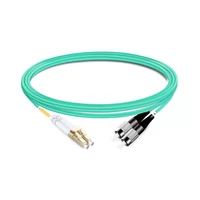 1m (3ft) Duplex OM3 Multimode LC UPC to FC UPC PVC (OFNR) Fiber Optic Cable
$2.80
1m (3ft) Duplex OM3 Multimode LC UPC to FC UPC PVC (OFNR) Fiber Optic Cable
$2.80
-
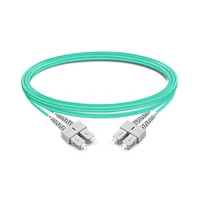 1m (3ft) Duplex OM3 Multimode SC UPC to SC UPC OFNP Fiber Optic Cable
$3.00
1m (3ft) Duplex OM3 Multimode SC UPC to SC UPC OFNP Fiber Optic Cable
$3.00
-
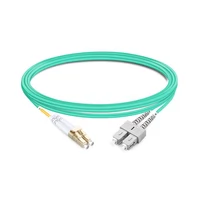 1m (3ft) Duplex OM3 Multimode LC UPC to SC UPC OFNP Fiber Optic Cable
$3.00
1m (3ft) Duplex OM3 Multimode LC UPC to SC UPC OFNP Fiber Optic Cable
$3.00
-
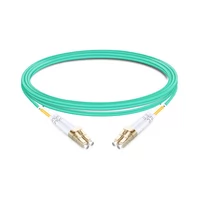 1m (3ft) Duplex OM3 Multimode LC UPC to LC UPC OFNP Fiber Optic Cable
$3.00
1m (3ft) Duplex OM3 Multimode LC UPC to LC UPC OFNP Fiber Optic Cable
$3.00
-
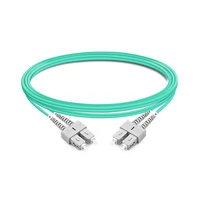 1m (3ft) Duplex OM3 Multimode SC UPC to SC UPC LSZH Fiber Optic Cable
$3.00
1m (3ft) Duplex OM3 Multimode SC UPC to SC UPC LSZH Fiber Optic Cable
$3.00
-
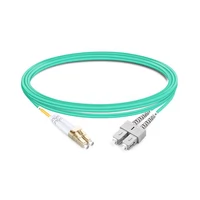 1m (3ft) Duplex OM3 Multimode LC UPC to SC UPC LSZH Fiber Optic Cable
$3.00
1m (3ft) Duplex OM3 Multimode LC UPC to SC UPC LSZH Fiber Optic Cable
$3.00
-
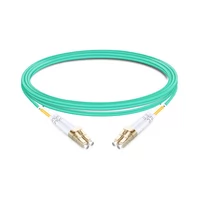 1m (3ft) Duplex OM3 Multimode LC UPC to LC UPC LSZH Fiber Optic Cable
$3.00
1m (3ft) Duplex OM3 Multimode LC UPC to LC UPC LSZH Fiber Optic Cable
$3.00
-
 1m (3ft) Duplex OM3 Multimode SC UPC to SC UPC PVC (OFNR) Fiber Optic Cable
$3.00
1m (3ft) Duplex OM3 Multimode SC UPC to SC UPC PVC (OFNR) Fiber Optic Cable
$3.00
-
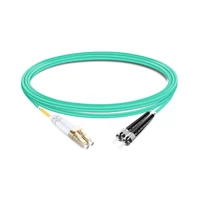 1m (3ft) Duplex OM3 Multimode LC UPC to ST UPC PVC (OFNR) Fiber Optic Cable
$3.00
1m (3ft) Duplex OM3 Multimode LC UPC to ST UPC PVC (OFNR) Fiber Optic Cable
$3.00
-
 1m (3ft) Duplex OM3 Multimode LC UPC to SC UPC PVC (OFNR) Fiber Optic Cable
$3.00
1m (3ft) Duplex OM3 Multimode LC UPC to SC UPC PVC (OFNR) Fiber Optic Cable
$3.00
-
 1m (3ft) Duplex OM3 Multimode LC UPC to LC UPC PVC (OFNR) Fiber Optic Cable
$3.00
1m (3ft) Duplex OM3 Multimode LC UPC to LC UPC PVC (OFNR) Fiber Optic Cable
$3.00
-
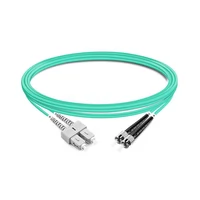 1m (3ft) Duplex OM3 Multimode SC UPC to ST UPC PVC (OFNR) Fiber Optic Cable
$5.20
1m (3ft) Duplex OM3 Multimode SC UPC to ST UPC PVC (OFNR) Fiber Optic Cable
$5.20
